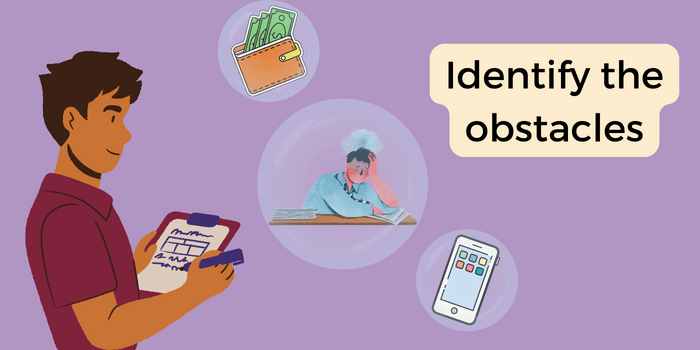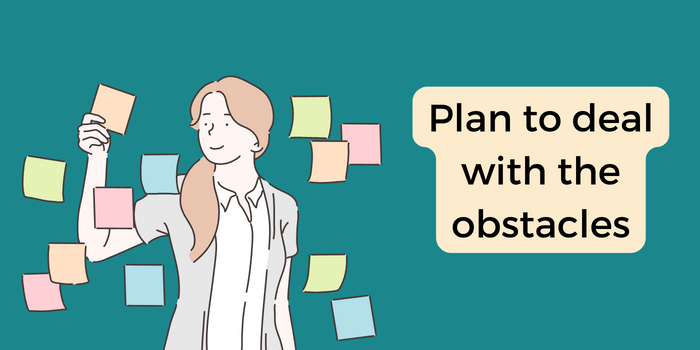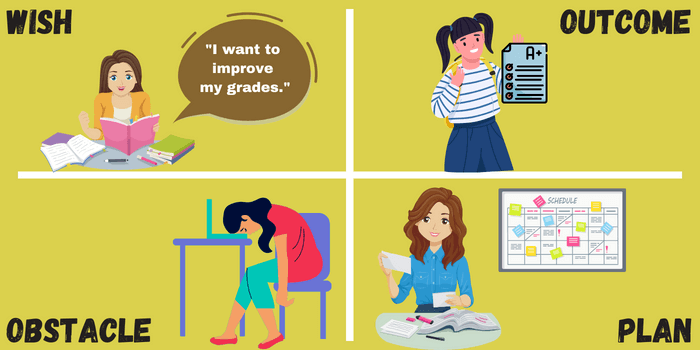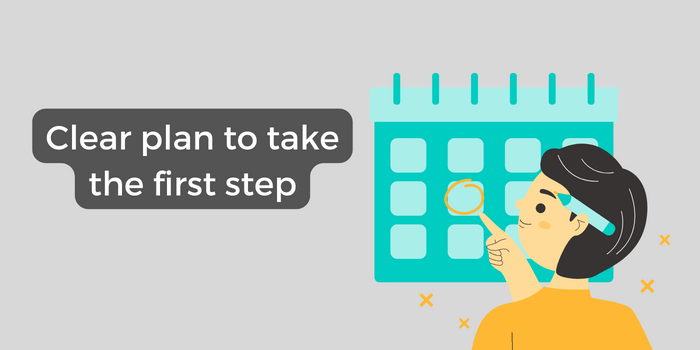Ever gone through a phase where you just can’t seem to find the motivation to work towards a goal? Or maybe you give up way too easily when faced with a challenge.
You’re not alone. We’ve all been there.
Take Anjali, for instance. She had always wanted to start her own small business, but every time she tried, she would get bogged down by self-doubt and the fear of failure. She would constantly tell herself, “I’m not cut out for this,” and before she knew it, she was back to square one.
It’s easy to set goals, but achieving them is a different story altogether.
That’s where WOOP comes in. Developed by Gabriele Oettingen, Professor of Psychology at New York University, WOOP is a goal visualization technique that can help you turn your dreams into reality.
WOOP stands for Wish, Outcome, Obstacle, Plan.
Step 1: Wish – Specifying your wish
Wishing is the first step of WOOP, and it’s the foundation of the technique.
Specify your wish in simple, clear, and concise words. The key is to keep it achievable, realistic, and attainable.
Ask yourself, “What do I really want?”
Write it down on a piece of paper and make sure it’s something that resonates with you.
Step 2: Outcome – Imagining the best outcome
Next, imagine the best outcome possible.
Visualize what it would feel like to have achieved your goal. See yourself living in that reality, and allow yourself to bask in the feelings of accomplishment and satisfaction.
Create a positive and inspiring mental image, something that you can hold on to and look back on when you’re feeling discouraged.
Write it down. Capture those feelings.
Step 3: Obstacle – Identifying existing obstacles
Now comes the time to be honest with yourself.
Identify the obstacles that could prevent you from achieving your goal. These obstacles could be internal or external, and they could range from self-doubt to a lack of resources.
Prioritize these obstacles based on their significance and the likelihood of them happening. The goal is to face the most significant and likely obstacles first.
Step 4: Plan – Dealing with the obstacles
Now plan how you will deal with these obstacles.
This is where you get to be creative. Come up with strategies that will help you overcome the obstacles and move closer to your goal.
For each obstacle, have a clear plan in place, so you know exactly what to do when the going gets tough. The more specific and detailed the plan, the better.
Write it down, so you can refer back to it later when the obstacles actually come to pass.
Benefits of WOOP
WOOP is a simple and straightforward process that can be used by anyone, regardless of their background or experience.
Here are some of its benefits.
Improving motivation
By visualizing the best outcome and actively working towards it, WOOP increases your motivation and drive to achieve the goal.
Improving focus
WOOP helps you break down the goal into manageable steps. It also shows how to remove obstacles that can derail your focus.
Better self-awareness
WOOP asks you to think about the common obstacles which typically lead to failure in achieving goals. This increases your self-awareness and leads to personal growth.
Higher resilience
By preparing you to deal with potential obstacles, WOOP enhances resilience and reduces the impact of setbacks.
Higher chances of goal attainment
By providing a clear path towards goal attainment, WOOP can increase the likelihood of successfully achieving goals.
WOOP is a tool that can help you turn your dreams into reality and turn your “what ifs” into “I did it!”
WOOP in Action: Real-Life Examples
Let’s consider a few scenarios to illustrate how WOOP can be used in real life.
- Amrita is a college student who wants to improve her grades. She struggles with procrastination and lack of focus.
- Joseph is a fitness enthusiast who wants to run a marathon. He’s worried about getting injured. He also lacks self-discipline, so he does not do enough practice.
- Akshay is a professional who wants to advance in his career and earn a higher salary. He lacks confidence in himself and constantly doubts his abilities.
In each of these examples, WOOP can help the individual break down their goal into achievable steps and create a plan to overcome the obstacles in their way.
Here is how they could go about it.
Ex 1: A student setting goals
Amrita wants to improve her grades, but keeps procrastinating on her studies. She gets caught in a cycle of putting off studying until the last minute and then feels overwhelmed and unable to concentrate.
The result is stress, poor performance, and a lack of motivation to continue.
But, with WOOP, Amrita can break this cycle and take control of her academic success.
Wish: Amrita specifies her wish in simple words – “I want to improve my grades.”
Outcome: She imagines the best outcome – she visualizes herself proud and confident, holding her report card with high grades, and her parents, teachers, and friends congratulating her.
Obstacle: Now Amrita identifies existing obstacles within herself. Her main problems include her tendency to procrastinate and inability to focus. She thinks about how likely these obstacles will occur and how serious they are.
Plan: Now that Amrita knows what she is dealing with, she will come up with a plan on how to tackle these problems. For example, she decides to create a study schedule and stick to it. She finds a study buddy to keep her accountable. She also takes frequent breaks to recharge her focus and energy.
Study smarter, not harder
By using WOOP, Amrita now has a roadmap to follow to achieve her goal of improving her grades. By breaking down her goal into manageable steps, she can avoid the stress and frustration that comes with procrastination.
With WOOP, she can study smarter, not harder, and achieve her desired outcome of improving her grades.
Ex 2: A fitness enthusiast wants to run a marathon
Joseph wants to run a marathon, but his fear of injury and lack of self-discipline hold him back.
He is not confident about pushing his body to its limits. He also feels overwhelmed about the necessary lifestyle changes and discipline to stick to the training.
Let’s see how WOOP can help Joseph.
Wish: Joseph specifies his wish in simple words – “I want to run a marathon.”
Outcome: He visualizes the best outcome – crossing the finish line, proud and triumphant, with friends and family cheering him on.
Obstacle: Joseph now lists down the most likely obstacles – his fear of injury and lack of self-discipline. He prioritizes these problems based on how likely these issues can come up, and how much they will impact his goal achievement.
Plan: Now he plans how to deal with these obstacles. He decides to seek advice from a professional trainer to develop a safe and effective training plan. He will enlist the support of friends to keep him accountable. He focuses on the mental and emotional benefits of running to overcome his fear of injury.
Taking the first step
WOOP provides Joseph with the motivation and structure he needs to stay on track and reach his goal of running a marathon.
By creating a clear plan to deal with his fears and lack of discipline, he can take the first step towards achieving his dream.
Ex 3: A professional seeks career advancement
For Akshay, self-doubt and lack of confidence have always been major problems, though he is a good performer at his company.
Fear of failure, the pressure to perform, and the constant comparisons to others – all contribute to his lack of confidence and a sense of inadequacy.
Let’s see how WOOP can help Akshay.
Wish: Akshay specifies his wish in simple words – “I want to advance in my career.”
Outcome: He imagines the best outcome – he sees himself in a new role, taking on new challenges, and making a real impact in his field. He visualizes his bosses giving him great reviews and congratulating him.
Obstacle: Joseph thinks about what is holding him back. He identifies self-doubt and lack of confidence as his usual negative patterns.
Plan: Now Joseph thinks deeply about how to deal with these problems. He writes his thoughts down to clarify and come up with a solid plan. He decides to seek mentorship or coaching to develop his skills and build his confidence. He will recut his resume and LinkedIn profile to focus on his strengths and accomplishments. He will take on a more visible role at the office, and he will share his learnings online to showcase expertise.
Motivation and structure to stay on track
WOOP provides Akshay with the motivation and structure he needs to stay on track and reach his career goals.
Now it’s your turn
WOOP is a powerful and simple goal visualization technique that can help you turn your dreams into reality.
By breaking down your goal into four manageable steps – Wish, Outcome, Obstacle, and Plan – you can overcome the obstacles in your way and move closer to your desired outcome.
Don’t give up on your dreams. Embrace WOOP and watch as your goals become a reality. You can do it!






